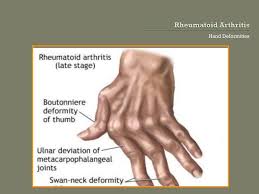WHAT IS IT?
Rheumatoid arthritis is an autoimmune disorder, it occurs when your immune system mistakenly attacks your own body’s tissues. Mainly affecting the lining of the joints, this chronic inflammatory condition causes a painful swelling that can eventually result in joint deformity.
Rheumatoid arthritis can also affect other tissues throughout the body including the skin, eyes, lungs, heart and blood vessels. However, rheumatoid arthritis is most common in the wrist and knuckles of the hand, and typically presents in both hands. Common symptoms of the condition are joint pain and stiffness, these can progressively worsen over a period of weeks or months. Females are three times more likely develop rheumatoid arthritis than males.
HOW IT PRESENTS?
Joints are usually affected on both sides of the body and typically the small joints of the hand, like the base or middles joints of the fingers, are the first to be affected. The joints of the hand may present with symptoms of pain, stiffness, redness, warmth to the touch, and swelling. Joint stiffness is usually worse in the mornings or after periods of joint inactivity. Patients will often report tenderness when joints are squeezed, and hand’s grip strength is often reduced.
Rheumatoid arthritis can also cause rheumatoid nodules to develop. These are painless lumps that appear beneath the skin. Nodules most often occur on pressure areas of the body like on the underside of the forearm or on the elbow, but can also occur in other areas including the tendons of the hand.
Due to the inflammatory nature of rheumatoid arthritis early symptoms can also include fatigue, muscle pain, low grade fever and weight loss. Between 1-5 percent of people with rheumatoid arthritis develop carpal tunnel syndrome due to swelling compressing on the nerve around the wrist, this can cause symptoms of weakness and tingling and numbness in the hands.
Individuals with chronic or longstanding rheumatoid arthritis may develop hand deformities, particularly in the fingers, and the tendons on the back of the hand may become prominent and tight.
HOW DO WE ASSESS?
Although rheumatoid arthritis can mimic other diseases during its early stages, our highly trained Physiotherapist will perform a thorough history exploring potential risk factors and symptoms of the disease and will perform a clinical examination, investigating your joints for pain, swelling, redness and warmth, as well as changes in strength in the hand and wrist.
Referral to a Rheumatologist/General Practitioner may be suggested to perform blood tests or imaging. Individuals with rheumatoid arthritis often have an elevated rheumatoid factor and markers in the blood indicating the presence of an inflammatory process in the body. Imaging is usually used as a tool to track the progression of disease in your joints over time.
WHAT CAN WE DO?
At Physica our role in the treatment of rheumatoid arthritis of the hands is to relieve pain, reduce inflammation, and help preserve the structure and function of the hand. Treatment will include;
- Education on management.
- Passive and active exercises to improve and maintain range of movement of the joints of the hand and wrist.
- Strengthening exercises to maintain and improve muscle strength and endurance, and function of the hand.
In some cases, your physiotherapist may prescribe splinting of the joint to prevent deformities, reduce joint pain and improve joint function.

